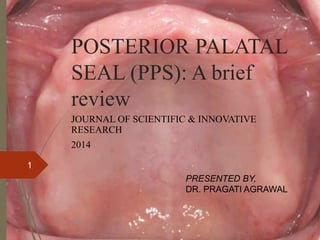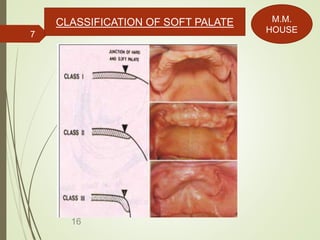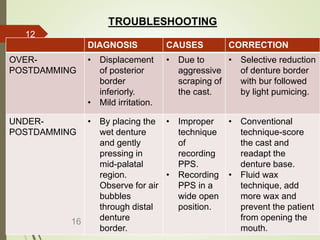posterior palatal seal
- 1. POSTERIOR PALATAL SEAL (PPS): A brief review JOURNAL OF SCIENTIFIC & INNOVATIVE RESEARCH 2014 1 PRESENTED BY, DR. PRAGATI AGRAWAL 16
- 2. INTRODUCTION ïī Posterior palatal seal area is stated as âthe soft tissues along the junction of the hard and soft palates on which pressure within the physiologic limits of the tissues can be applied by a denture to aid in the retention of the denture.â -- GPT 2 16
- 3. FUNCTIONS OF POSTERIOR PALATAL SEAL ïī Ettinger and Scandrett:- 1. to provide retention 2. prevents ingress of fluid, air, and food between denture and tissue 3. diminishes gagging reïŽex 4. provides embedded sunken distal border which is less conspicuous to tongue 5. supplies a thick border to counteract denture warpage due to dimensional changes during the polymerization shrinkage of methyl methacrylate resin. ïī Weintraub added following: 1. adds conïŽdence and comfort to the patient by enhancing retention 2. establishes a positive contact posteriorly, and therefore prevents the ïŽnal impression material from sliding down into the pharynx 3 16
- 4. 4 POSTERIOR PALATAL SEAL AREA PTERYGO- MAXILLARY SEAL POST PALATAL SEAL 16
- 5. 5 POSTERIOR PALATAL SEAL LIES BETWEEN ANTERIOR AND POSTERIOR VIBRATING LINES Anterior vibrating line is an imaginary line located at the junction of the attached tissues overlying the hard palate and the tissues of the immediately adjacent soft palate. Posterior vibrating line is an imaginary line at the junction of aponeurosis of tensor veli palatine muscles and the muscular portion of the soft palate. It represents demarcation between slightly movable part of soft palate and highly movable part of soft palate. 16
- 6. 6 LOCATING ANTERIOR VIBRATING LINE 1. Valsalva maneuver 2. Ah line â short vigorous burst LOCATING POSTERIOR VIBRATING LINE Ah line â short burst in a normal, unexaggerated fashion. 16
- 7. 7 CLASSIFICATION OF SOFT PALATE M.M. HOUSE 16
- 8. METHODS OF RECORDING POSTERIOR PALATAL SEAL ïī CONVENTIONAL APPROACH (WINKLER TECHNIQUE) 8 16
- 9. ïī FLUID WAX TECHNIQUE (FUNCTIONAL / PHYSIOLOGICAL) ïī ARBITRARY SCRAPING OF MASTER CAST 9 âĒ MODIFIED BORDER MOULDING TECHNIQUE 16
- 10. ïī EXTENDED PALATAL TECHNIQUE (SILVERMANN) âĒ Complete maxillary dentures can be extended for an average distance of 8.2 mm dorsally to the âvibrating lineâ or flexion line where the soft palate joins the hard palate. ïī BOUCHERâS TECHNIQUE âĒ The width of the posterior palatal seal is limited to a bead on the denture that is 1.5 mm deep and 1.5 mm broad at its base with a sharp apex. The resulting design is a beaded posterior palatal seal. 10 16
- 11. 11 DIAGNOSIS CAUSES CORRECTION OVER- EXTENSION âĒ Painful and difficulty in swallowing due to ulceration in soft palate. âĒ Rapid extension of denture base. âĒ Selective relief of pressure areas and minimize the distal length. UNDER- EXTENSION âĒ Loss of physical retention. âĒ Consideration of fovea palatine as the terminating border. âĒ Over-trimming due to fear of gagging. âĒ Adding a posterior palatal seal to existing denture. TROUBLESHOOTING 16
- 12. 12 DIAGNOSIS CAUSES CORRECTION OVER- POSTDAMMING âĒ Displacement of posterior border inferiorly. âĒ Mild irritation. âĒ Due to aggressive scraping of the cast. âĒ Selective reduction of denture border with bur followed by light pumicing. UNDER- POSTDAMMING âĒ By placing the wet denture and gently pressing in mid-palatal region. Observe for air bubbles through distal denture border. âĒ Improper technique of recording PPS. âĒ Recording PPS in a wide open position. âĒ Conventional technique-score the cast and readapt the denture base. âĒ Fluid wax technique, add more wax and prevent the patient from opening the mouth. 16
- 13. ADDITION OF POSTERIOR PALATAL SEAL TO EXISTING DENTURE ïī Moghadam and Scandrett âĒ Fluid wax technique for recording posterior palatal seal and addition of posterior palatal seal with auto-polymerizing acrylic resin. ïī Ansari âĒ Recording posterior palatal seal on existing denture using modeling compound and prepare a cast using putty material and replacing modeling compound with auto- polymerizing resin. 13 16
- 14. ïī Sato âĒ Adding posterior palatal seal immediately to existing denture by use of cross-linked reline resin, light polymerized reline resins, or dual polymerized reline resins with fabrication of silicone putty core intraorally. 14 16
- 15. CONCLUSION ïī The recording of posterior palatal seal is of great signiïŽcance, because it is vital factor in establishing the peripheral seal which enhances retention by utilizing the atmospheric pressure. ïī According to Tilton- No step in the denture construction should be stopped short of perfection. Thus, the posterior palatal seal should be prepared with an understanding of patient palatal throat form, anatomical boundaries, extent and depth of displaceable tissues for successful, retentive, functional, and biological acceptable complete denture prosthesis. 15 16
- 16. CROSS REFERANCES ïī The posterior palatal seal: Its rationale and importance: An overview; Shelly Goyal, Mukesh K Goyal, Dhanasekar Balkrishanan, Veena Hegde, Aparna I Narayana; European Journal of Prosthodontics | May- Aug 2014 | Vol 2 | Issue 2 | ïī Evolution of Techniques in Recording Posterior Palatal Seal â A Review; Rajakumari Natarajan, Priyadharshini Ramesh, Sunantha Selvaraj and Jayashree Mohan; Journal of Academy of Dental Education Vol 3 (1)| 2017 ïī Ansari IH. A procedure for adding posterior palatal seal to an existing denture in dental office. J Prosthet Dent 1994;72:449. ïī Sato Y. Immediate maxillary denture base extension. J Prosthet Dent 2000;83:371-3. 16 16















